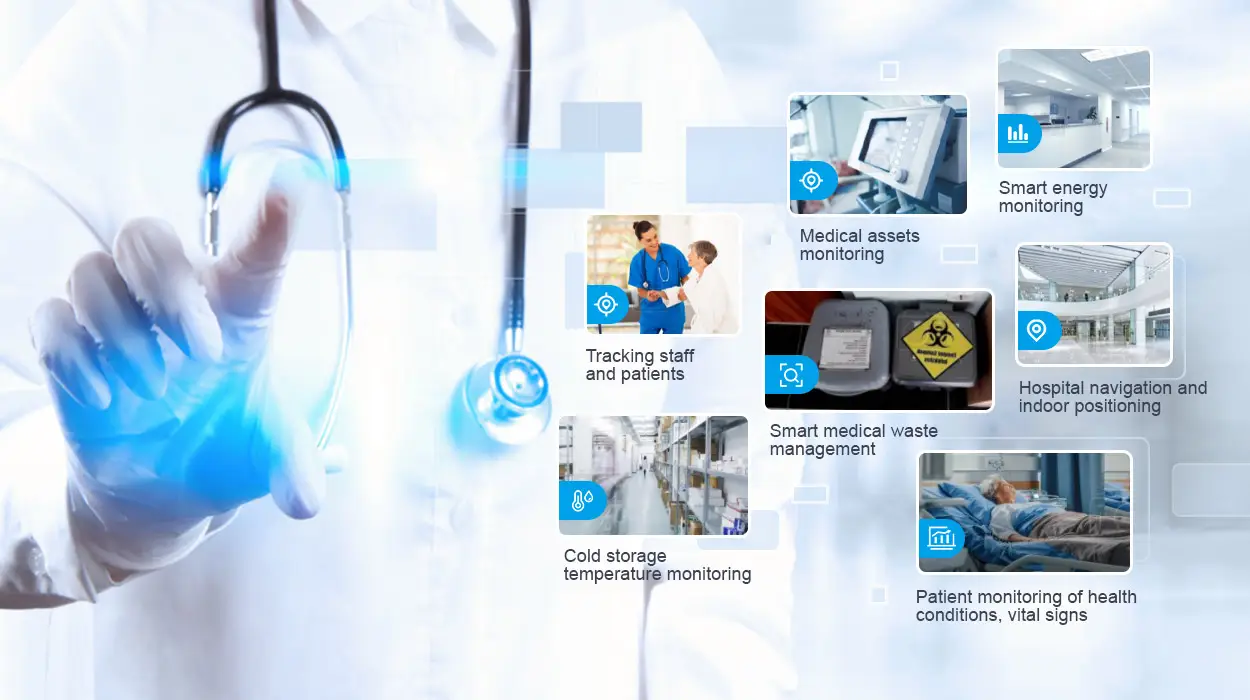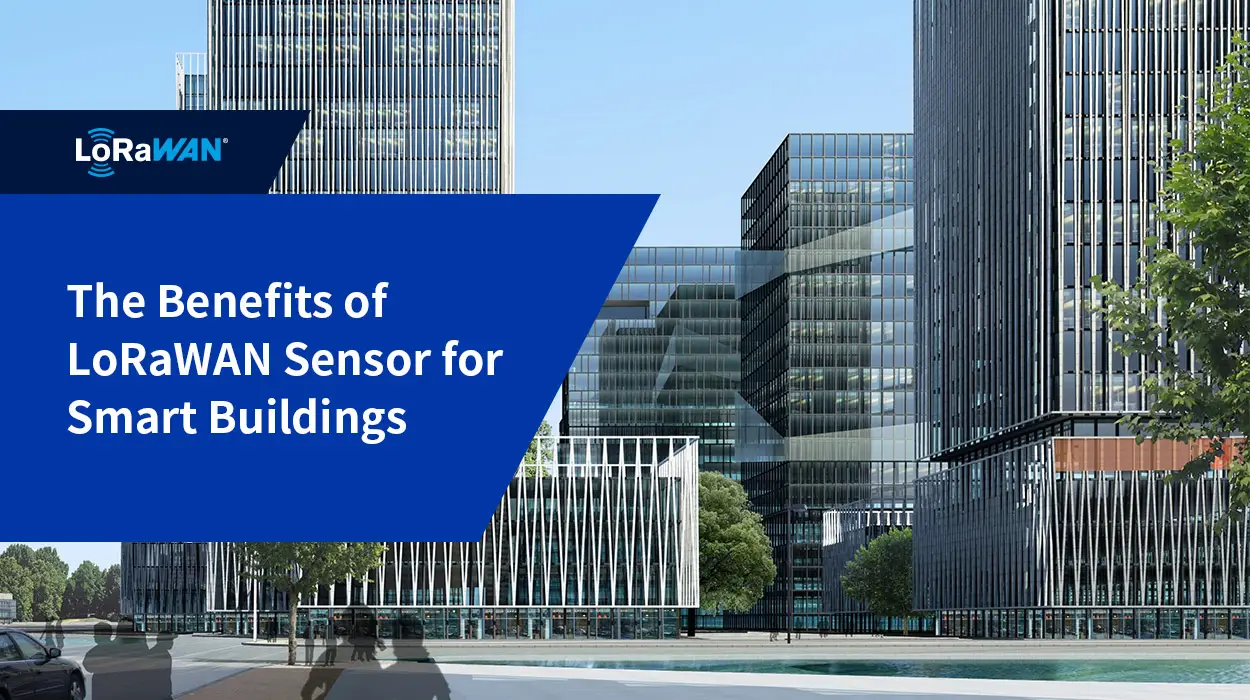As a highly integrated application of next-generation information technology, the Internet of Things is ideally suited for the healthcare industry to connect doctors and patients and smart medical devices in innovative ways. During the global pandemic, innovations in the healthcare industry continue to grow, delivering enormous benefits to patients, physicians, and hospitals. LoRa, a key component of IoT wireless connectivity technology, has huge opportunities for implementation in this connected ecosystem. In this post, we will explore seven best practices for leveraging LoRa technology in IoT smart healthcare.
What is IoT smart healthcare
The simple definition of IoT is to connect various physical objects together for exchanging data over the internet. And IoT smart healthcare is about connecting people, assets, and items related to medical business with the Internet for the purpose of connecting and exchanging information. The aim of IoT smart healthcare is to achieve intelligent identification, tracking, positioning, monitoring, and management of medical items. Typically, smart healthcare IoT devices are called the Internet of Medical Things(IoMT).
IoT technology is the core driver of smart healthcare. Although IoT implementations in smart healthcare may not always impress users, they are steadily improving healthcare service quality and processes, optimizing the medical experience, and even providing early diagnosis and treatment of serious diseases. As the potential of IoT in smart healthcare continues to expand, there is a growing focus on how advanced technologies can be used to enable interactions between patients, healthcare professionals, medical devices, and healthcare facilities.
Why choose LoRa in IoT smart healthcare solutions
With the development and breakthrough of communication technology, IoT technology has made great progress in the field of wireless communication technology such as WiFi, Bluetooth, Zigbee, LoRa, etc., and has been gradually promoted and applied in many industries. Though WiFi is a good choice in IoT smart healthcare, it consumes more power and requires IT support. Bluetooth is perfect for its low energy consumption features, but its transmission range is limited to 30m. Most medical equipment cannot meet the needs of Zigbee mesh networking.
In terms of LoRa, it is very suitable for medical applications due to its low power consumption, low cost, and wide coverage. LoRa applies a special spread spectrum technology that allows terminals with different spreading spectrum sequences to transmit simultaneously on the same frequency without interfering with each other. Unlike cellular networks that must communicate via base stations, LoRa establish networks with cheap modules and gateways. Moreover, it is easy for LoRa devices to integrate with other technologies.
What are the applications of LoRa in IoT smart healthcare
At present, there is a variety of LoRa applications in smart medical and healthcare sector. IoT smart healthcare solutions consisting of LoRa-enabled sensors and gateways are proving to be an efficient means of monitoring patients and medical assets, delivering fast and accurate service while ensuring health and medical safety priorities. Let’s dive into some of the best applications of LoRa technology in IoT smart healthcare.

Tracking staff and patients
Hospitals are often crowded, with patients, doctors, nurses and staff moving around, making it difficult to keep track of their locations. By wearing our LoRaWAN contact tracker, it is possible to achieve continuous tracking of their location. In case of an emergency, the patient can trigger the emergency button to call for help, and the medical staff can make a quick response and obtain information such as the patient’s location, thereby verifying the patient’s identity and ensuring correct treatment.
Let’s take the example of tracking the location of Alzheimer and dementia patients in real time. LoRaWAN-enabled contact tracker provides continuous and reliable location data of the patients. Once they leave the designated safe zone, the devices will promptly alert caregivers to ensure maximum patient safety.
Cold storage temperature monitoring
Pretty much pharmaceuticals have extremely strict requirements for storage conditions. For example, vaccines should be stored at the recommended temperature of 2°C to 8°C, otherwise, their efficacy will be reduced or even destroyed. The LoRa-enabled wireless cold chain management system is well-suited to monitor the real-time temperature and humidity of drugs, whether they are in transit or stored in the pharmacy room. With our LoRaWAN Temperature & Humidity Sensor LW002-TH, you are accessible to the up-to-date ambient temperature data.
Medical assets monitoring
Medical equipment in hospitals such as PACS carts and ventilators, often move between different departments. Therefore, when the device is in need, the problem of the device not being found or even being lost often occurs. With the help of IoT positioning technology and our LoRaWAN GPS tracker, information such as device location and status can be determined in real-time, and the device can be found quickly. In comparison with the traditional manual assets management, LoRa solution makes medical asset tracking simpler, safety, and better.
Patient monitoring of health conditions, vital signs
Medical monitoring mainly focuses on detecting and monitoring the physiological and pathological states of patients. It continuously monitors patient health metrics, activity, and vital signs, including body temperature, blood pressure, insulin levels, heart rate, and more. By monitoring the sensors worn on the patient, doctors can know the condition of the patient being monitored anytime, anywhere. These sensors are wirelessly connected to the doctor’s mobile terminal device through LoRa, thereby medical staff can specify symptomatic treatment in time and reduce response time to provide assistance to patients in need.
Hospital navigation and indoor positioning
Facing the large and complex hospital building, many patients often can’t find the department or ward they want. Most of their time in medical treatment is wasted searching for departments, queuing for registration, and waiting for examinations. Bluetooth beacons can be integrated with LoRaWAN Bluetooth gateway to form a reliable and efficient indoor navigation system that provides path guidance for patients. Combined with voice prompts and real-life display of key locations, it can help patients rationally choose paths and easily find medical destinations.
Smart energy monitoring
The variety of complex medical equipment in the medical system often has a large demand for energy, and it is easy to occur that the equipment in the non-use state has not been powered off for a long time, leading to the waste of energy consumption. The LoRaWAN gateway collects all these various energy consumption data, and sends them to the cloud for further analysis. By monitoring and analyzing the energy consumption of medical devices with smart meter plug, it can effectively optimize equipment utilization, reduce energy consumption costs, and improve patient experience and satisfaction.
Smart medical waste management
Given the particularity of medical sites and businesses, hospitals need to track medical waste. The purpose of locating medical waste is to clarify the responsibilities of hospitals and transportation companies, and prevent illegal dumping of medical waste and pollution of the hospital environment.
By establishing a medical waste management system supported by LoRaWAN, it is possible to realize transportation tracking of medical waste. LoRaWAN GPS tracker is installed to collect the location information of various medical waste, thereby realizing the query and supervision of various medical waste treatments.
What is the future of IoT in smart healthcare
It’s difficult to predict the next step of IoT medical devices in smart healthcare, but what is clear is that people are investing more in IoT innovations in smart healthcare. According to Grand View Research, the smart healthcare market is estimated to grow from $153.6 billion in 2021 to $483.4 billion in 2030 at a CAGR of 13.3%. The future of IoT will have a greater opportunity to have a positive impact on the healthcare industry as the technology evolves and more competitors in the industry come in.
In near future, we are optimistic to see that IoT for healthcare become a stable and feasible solution for the healthcare system. With the popularization of IoT technology and its full integration with 5G, cloud computing, big data, RFID, BLE and other technologies, IoT smart healthcare solutions will show stronger influence and productivity. In short, the Internet of Things technology will continue to witness significant growth and further digital transformation in healthcare.
Getting started with MOKOLoRa IoT solutions
Healthcare is one of the biggest challenges facing every country today. To address health concerns in the post-COVID-19 era, leveraging LoRa devices and wireless radio frequency technology is ideal for critical smart healthcare. MOKOLoRa is a leading IoT manufacturer globally, focusing on LoRaWAN smart devices, and is your best partner to tailor IoT smart healthcare solutions. Our MOKOLoRa will help you get robust and cost-effective LoRaWAN devices and actionable insights. Talk to our LoRa expert and make the most out of our LoRaWAN innovations!










